The Unbridled Truth About Dividends Contribution to Shareholder Profitability
Companies / Dividends Nov 27, 2012 - 11:47 AM GMT The Two Components of Total Return
The Two Components of Total Return
There have been many recent published articles and discussions that indicate that dividends have become the Rodney Dangerfield of the investing world. In short, dividends get no respect, as many believe that dividends do not add to a shareholder’s profitability. We believe that dividends represent a return bonus. This article is written to provide evidence of our thesis.
“The following is the definition of total return according to investopedia:
When measuring performance, the actual rate of return of an investment or a pool of investments over a given evaluation period. Total return includes interest, capital gains, dividends and distributions realized over a given period of time. “
With the above definition in mind, perhaps the best place to start is by examining the two primary components of total return in order to put everything in perspective. But before we go on, we are utilizing the phrase “total return” as synonymous to the word “profitability.” In other words, an investor’s profitability logically must be measured as the total return they receive on their investment. Total return is a function of two primary components, capital appreciation and income. Of course, investments that do not generate an income stream (dividends, interest or distributions) will only possess the capital appreciation component.
Capital appreciation (or depreciation) is simply the difference between the price you originally paid for an investment, and the price it currently can be sold at. More simply stated, it is the increase in the price or value of your asset. Since our focus with this article is on publicly traded common stocks, the capital appreciation component represents the difference between the price you paid and the price the stock currently trades at. For non-dividend paying common stocks, this will be the sole source of your total return. Capital gains are synonymous with capital appreciation.
The second component of total return is the income component. As stated in the definition, this will include interest, dividends or distributions. Since we are focusing on dividend paying stocks, we will be analyzing dividends as our income component. At this point, we should focus the reader to the fact that by the very definition of total return, the income component represents a return in addition to the capital gain or appreciation component. Therefore, and again by definition, the dividend represents an additional return above and beyond the capital gains. This alone adds credence to the notion that dividends represent a return bonus as we had postulated in our previous article.
Real-world Evidence Validating the Dividend Bonus
We will utilize the F.A.S.T. Graphs™ (fundamentals analyzer software tool) as a vehicle for providing clear, and we feel undeniable evidence, that dividends augment total return. In order for us to accomplish this objective, it is imperative that the reader clearly understands what the F.A.S.T. Graphs™ are depicting. Therefore, with our first example, Acenture (ACN), we will build the earnings and price correlated graph one element at a time.
Accenture (ACN): Annualized Earnings Growth Rate 17.3%, Capital Appreciation 14.4%
Accenture is a global management consulting, technology services and outsourcing company. The orange line on the first graph plots Acenture’s fiscal operating earnings-per-share since 2003, and represents the calculated intrinsic value of the company. The green shaded area represents the total cumulative earnings that the company has generated. The important fact for the reader to note with this graph is that earnings have steadily increased at a very high rate, with the exception of the modest flattening during the great recession. As we will show next, these earnings are what the market will capitalize in order to generate and calculate capital appreciation for Acenture since 2003.
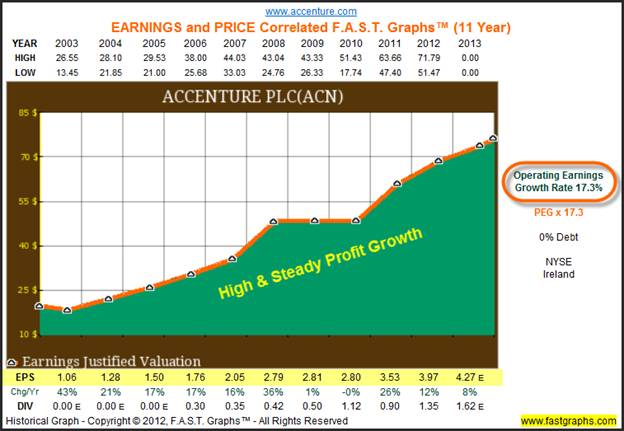
With our next graph we add the element of monthly closing stock prices overlaid and correlated to the orange earnings justified valuation line. Since we are often accused of cherry picking, the reader should note that this example, and all the other examples utilized in this article, were hand selected based on valuation. In other words, in order to eliminate any market mispricings or anomalies, we are only reviewing companies where the beginning price and ending price is at or near fair value based on the black price line touching the orange valuation line.
When looked at in this manner, the source of capital appreciation is vividly depicted without any market inefficiencies or bias. Therefore, the reader can see that it is the earnings of the company that drive stock prices over the long run. Moreover, the reader can also see that the entire complement of earnings are what the market is tracking. There is no adjustment being made for dividends paid, which we will look at later. Once again, this capital appreciation component (capital gains) is not affected or adjusted by dividends in either direction. Furthermore, it is clear that market forces will drive prices above the justified earnings line and below it from time to time, but inevitably price always moves back into alignment with earnings.
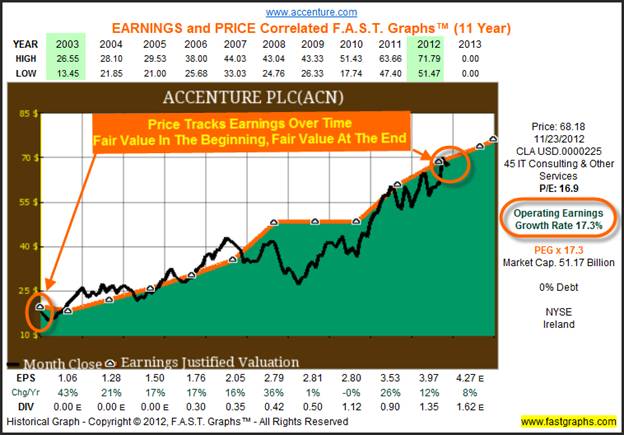
The capital appreciation component for Acenture shows that a $1000 investment on 12/31/2002 is now worth $3790.13. This is a function of the share price rising from $17.99 to the closing price on 11/23/2012 of $68.18. At this point, there is no dividend income included in the calculation, just pure capital appreciation based on earnings growth.

With our next graphic, we now bring dividends (the light blue shaded area) into the equation. Notice that we stack the dividends on top of the earnings line even though they are paid out of the green shaded area. This article, and the previous article that we authored and linked to, provide an insight and justification for why we present the graphs in this manner. It should be clear by examining the graphic that all of the company’s earnings are being capitalized in order to create the capital appreciation component.
It should also be clear that the dividend paid represents an additional component to total return. By having the light blue shaded area stacked on top, this reality becomes visibly apparent. Furthermore, dividends do represent a return in addition to capital appreciation thereby making an important contribution to shareholders’ total returns (profitability). The green and light blue lines with dots at the end are color-coded showing the portion of earnings paid out as dividends. The green line represents earnings, the light blue represents dividends.
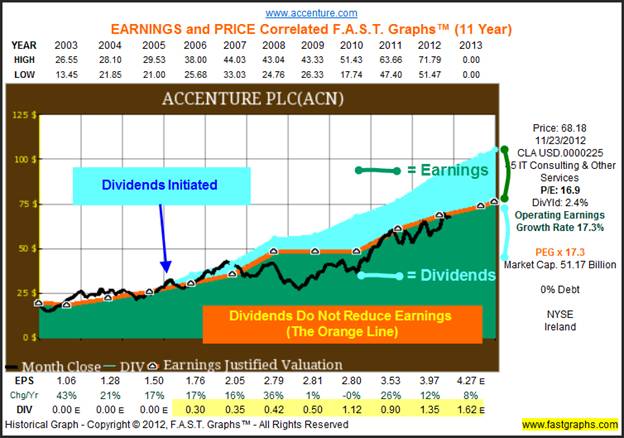
We can now see the total return performance for Acenture, while simultaneously examining each of the total return components, capital appreciation and dividend income. Moreover, we can review each of these components independently and then collectively. As we previously reported, Acenture shareholders enjoyed a 14.4% annual capital appreciation. However, in addition to capital appreciation that closely mirrored the company’s earnings growth, shareholders received an additional $274.91 of cumulative total dividend income (dividends paid out and not re-invested) which increased their total annual return from 14.4% to 15.2% per annum.
The most important point here is that the capital appreciation component would have been the same whether or not Acenture paid their shareholders a dividend. Moreover, the dividend added almost a full percentage point of annual return to their results. Dividends, are clearly a bonus, or a return in addition to the capital appreciation component.
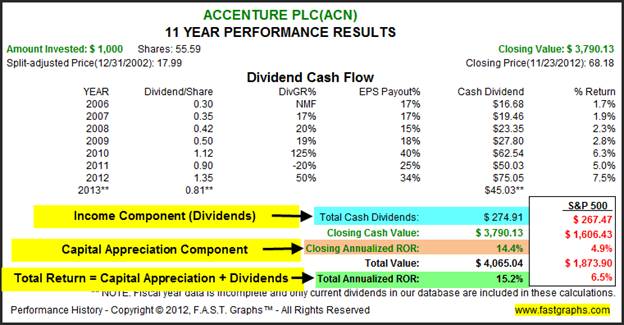
Additional Evidence
The following earnings and price correlated graphs with dividends are offered to provide additional evidence clearly revealing the undeniable fact that dividends are a return enhancement. In order to illustrate this as plainly as possible, we will present three categories of companies ranging from low growth, moderate growth, and finally fast growth. Then, for an even greater perspective we will review a company that paid a very large special one time extra dividend.
As we did with the Acenture example, we will only utilize time frames where beginning and ending valuation are in alignment with the orange earnings justified valuation line. Therefore, the reader can vividly see that the company’s earnings growth rate drives its capital appreciation component, and that its income component, the dividend, provides an additional return.
But perhaps most importantly, it will be clear that the dividend does not diminish the value of the company. The true worth of the company is a function of its record of earnings growth as long as fair value is in alignment both at the beginning and at the end of the period. In other words, market mispricing biases are excluded from the presentation.
Here are the key things to focus on as you review the following earnings and price correlated graphs plus dividends examples. First of all, notice how the black price line tracks and correlates with the orange earnings justified valuation line. Then, notice that dividends do not diminish or reduce the orange line (earnings). The companies earnings (the orange line) are capitalized by the market assigning the appropriate P/E ratio based on the company’s earnings growth. The P/E formula is price divided by earnings (P/E), and not price divided by earnings minus dividends. Finally, by stacking them on top, notice that the light blue shaded area representing dividends paid out of earnings, the green shaded area, are vividly depicted as return in addition to capital appreciation.
When reviewing the associated performance graphs for each sample company, notice how the company’s capital appreciation component will correlate very closely with the company’s earnings growth rate. This clearly validates the fact that earnings, all earnings, drive the stock price. Moreover, recognize that the company’s full complement (total earnings) of earnings are capitalized generating the capital appreciation component. Then, notice how the income component, or the dividends, provide the additional return which augments and enhances the capital appreciation component.
Low Growth Examples
Vectren Corp: (VVC): Annualized Earnings Growth Rate 1.9%, Capital Appreciation 1.6%
Vectren Corporation is an energy holding company headquartered in Evansville, Indiana. Since our low growth examples (5% earnings growth or less) generate low capital appreciation because earnings growth is so low, the importance of dividends is vividly revealed. As a reminder, notice that the full compliment of earnings (the orange line) are capitalized by the market. This is especially illuminating when you consider the high payout ratios which are common with low growth companies. In other words, even though these companies pay out very significant portions of their earnings, the capital appreciation component is still based on the company’s total earnings reported.

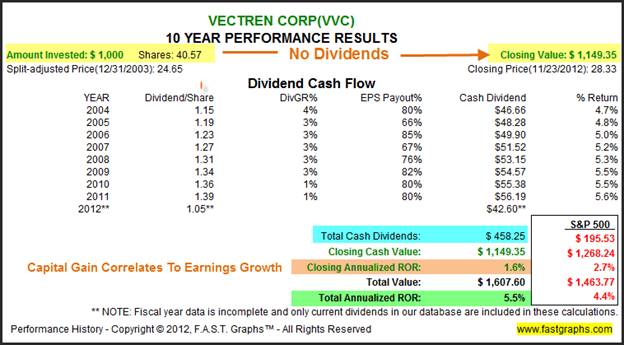
WGL Holdings, Inc.: (WGL): Annualized Earnings Growth Rate 2.7%, Capital Appreciation 2.4%
Washington Gas distributes natural gas to customers in the District of Columbia, Maryland and Virginia.
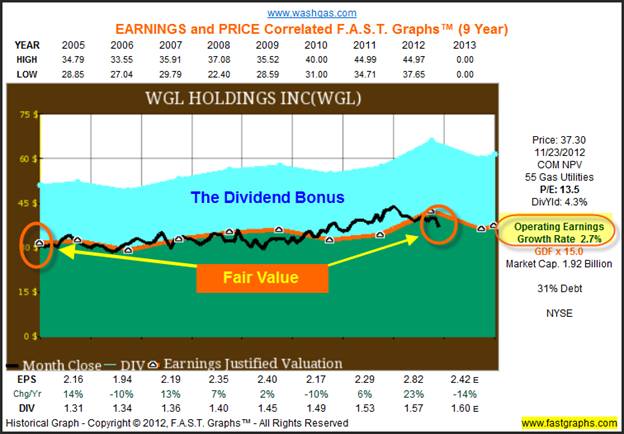
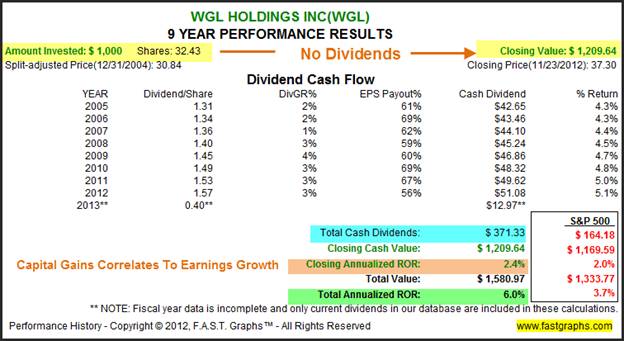
Moderate Growth Examples
The following moderate growth examples (8% to 12% earnings growth) generate capital appreciation that is highly correlated to the company’s earnings growth rate. Once again, all earnings are capitalized, and the dividend generates a return in addition to capital gains. The reader might also notice that the big differences here are lower payout ratios and a greater contribution to total return from capital gains rather than dividends. Nevertheless, the thesis that dividends provide a bonus return is clear.
Baxter International, Inc.: (BAX): Annualized Earnings Growth Rate 9.9%, Capital Appreciation 9.6%
Baxter International Inc., through its subsidiaries, develops, manufactures and markets products that save and sustain the lives of people with hemophilia, immune disorders, infectious diseases, kidney disease, trauma, and other chronic and acute medical conditions.
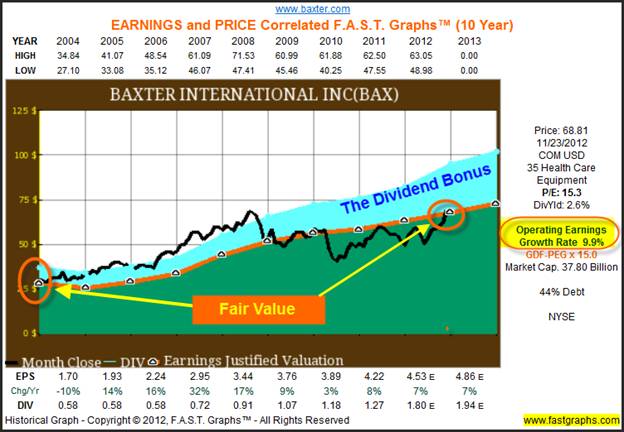

Brinker International, Inc.: (EAT): Annualized Earnings Growth Rate 9.8%, Capital Appreciation 8.1%
Brinker International, Inc. is one of the world’s leading casual dining restaurant companies. With more than 1,500 restaurants and over 100,000 team members in 32 countries and two territories, Brinker and its brands welcome more than one million guests into our restaurants every day.
The Brinker International Inc. (EAT) example below offers additional insight into the contribution of dividends to total return, because the company did not start paying dividends until 2006. Therefore, we can see the capital appreciation component was there even when the company was not paying dividends. Moreover, we can see that dividends added a bonus return above capital appreciation after they were started.
Importantly, there are additional insights regarding the value of dividends that the Brinker International Inc. example provides us. From the dividend cash flow table on the performance report you will see that Brinker International Inc. was able to continue increasing their dividend each year even though earnings per share and stock price were falling.
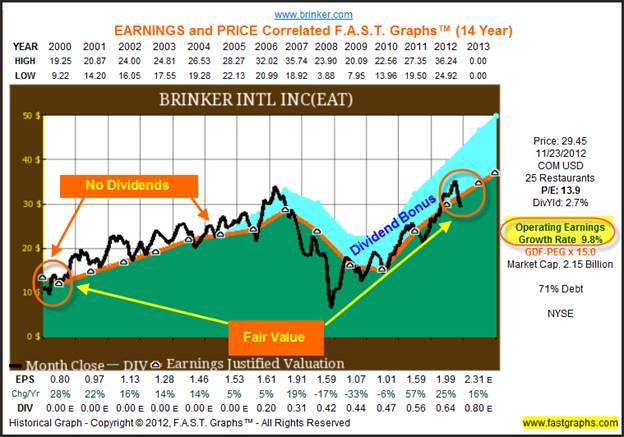
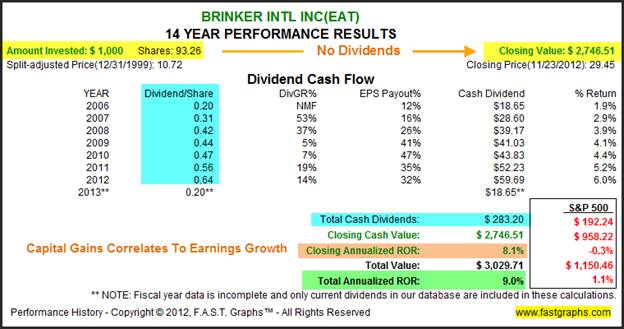
Although the above earnings and price correlated graph with dividends provides the illusion that dividends are dropping because they are stacked on top of the falling earnings line (the orange line), a review of the performance table shows that the payout ratio increased because of the decreasing earnings, but that the actual dividends themselves were increased each year.
The following graphs look at the time frame calendar years 2005 to 2010. We offer this graph to illustrate that during a period of falling earnings and stock prices, the rising dividend income component provided shareholders a buffer. Thanks to the dividend income, shareholders almost broke even, therefore, the value of dividends during difficult times are also highlighted.

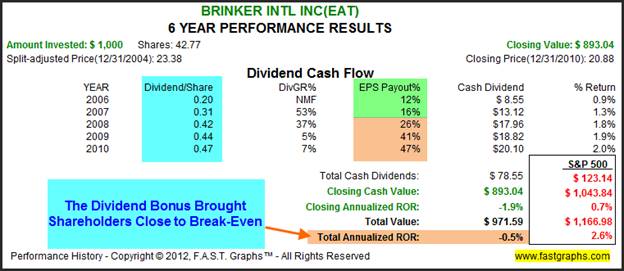
Fast Growth Examples
The following fast growth examples (greater than 15% earnings growth) provide compelling evidence that earnings growth generates capital appreciation, regardless of whether dividends are paid or not. On the other hand, by examining the long-term performance of these companies we can clearly see that the dividends do provide a return kicker.
Raven Industries, Inc.: (RAVN) Annualized Earnings Growth Rate 19.9%, Capital Appreciation 23.1%
Since 1956, Raven Industries has designed and manufactured high-quality, high-value technical products.

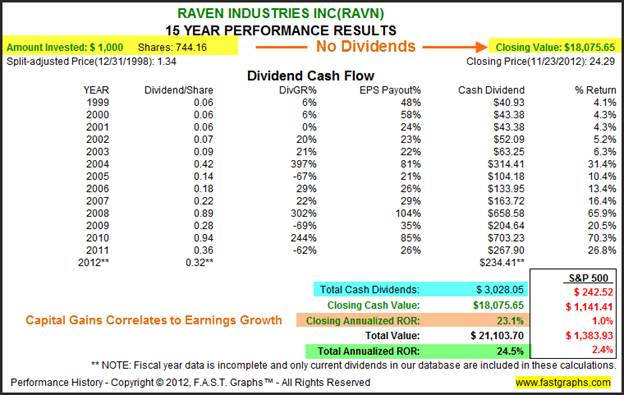
Ross Stores, Inc.: (ROST) Annualized Earnings Growth Rate 18.9%, Capital Appreciation 19.5%
Ross Stores, Inc. is an S&P 500, Fortune 500 and Nasdaq 100 (ROST) company headquartered in Pleasanton, California. The Company operates Ross Dress for Less® ("Ross"), the largest off-price apparel and home fashion chain in the United States with 1,097 locations in 33 states, the District of Columbia and Guam.
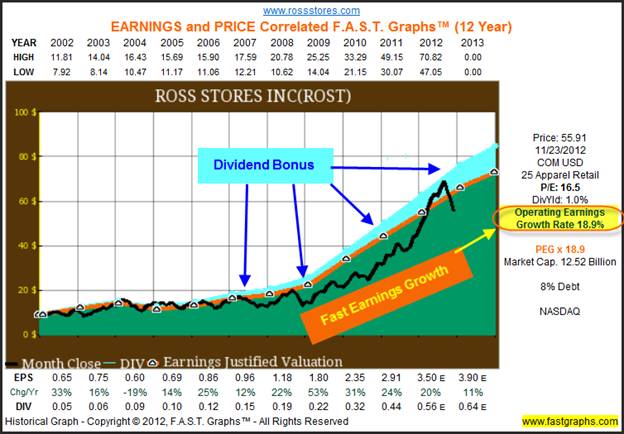
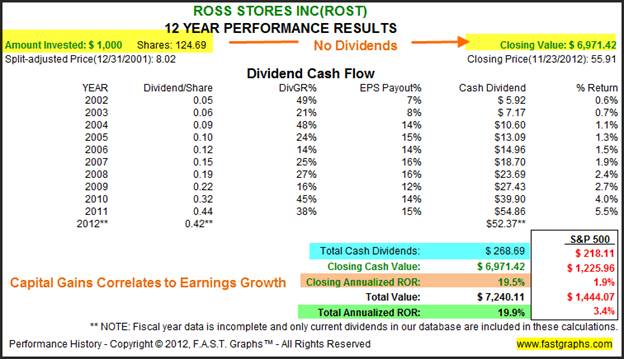
Special Dividend Example
Coca-Cola Enterprises Inc.: (CCE)
Coca-Cola Enterprises is one of the world’s largest Coca-Cola bottlers operating locally in eight territories in Western Europe.
Our final example reviews Coca-Cola Enterprises Inc. (CCE) because the company declared a large $10 special dividend in October of 2010. With this example, it is clear that the ex-dividend date did cause a huge temporary drop in the company’s price due to its magnitude (see red circle). However, we also see that the company’s earnings were not decreased and that the company’s stock price eventually moved back into alignment with its earnings. This picture provides a stark and vivid depiction that dividends ultimately provide a return bonus.
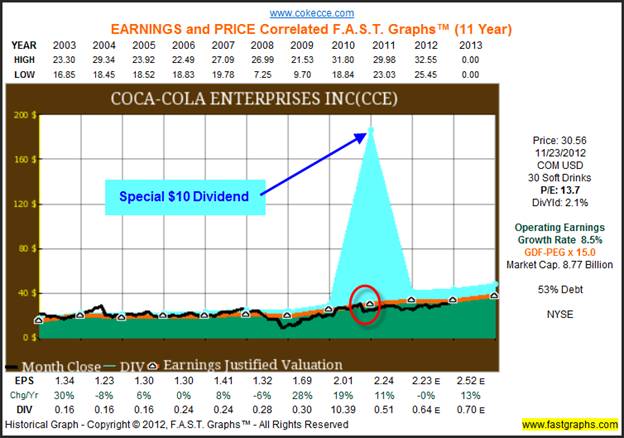
The following graph courtesy of Google Finance shows that the ex-dividend adjustment, even a very large one like a $10 special dividend that Coca-Cola Enterprises paid out, can have less of an impact on stock price than normal price volatility does. It is clear that there is an adjustment, but it should also be clear that normal trading activity soon renders the adjustment moot.
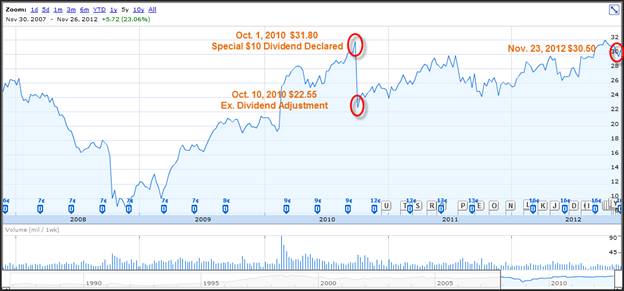
The following earnings and price correlated plus dividends shorter graph on Coca-Cola Enterprises dramatically illustrates the dividend bonus concept we are writing about. With this graph, we see capital appreciation generated by earnings, we see the ex-dividend adjustment, as large as it was, soon mitigated, and we see an in-our-face picture of the dividend bonus.
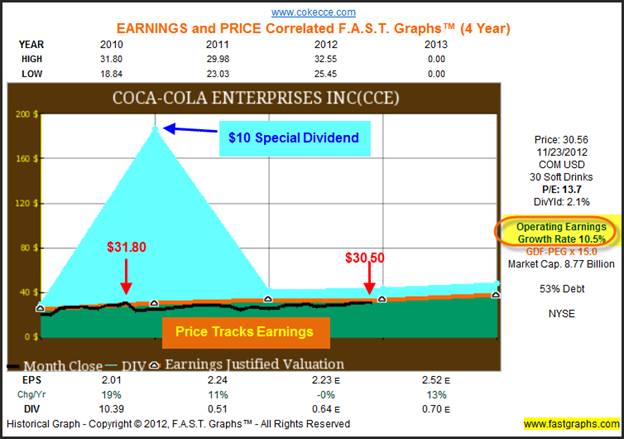
When reviewing the performance of Coca-Cola Enterprises since calendar year 2010, the year they declared a special $10 dividend, we are provided undeniable evidence that dividends provide a bonus return. From the graph above you will notice that initially there was the ex-dividend effect, however, the stock price moves steadily back into alignment with earnings even after such a large ex-dividend adjustment.
But most importantly, the performance report shows that the capital appreciation component correlated to (actually exceeded) the company’s total earnings growth. But even more importantly still, we see that this huge special one-time dividend essentially doubled the company’s total return during this time frame. Clearly, we see that the special dividend was indeed a bonus to shareholders.
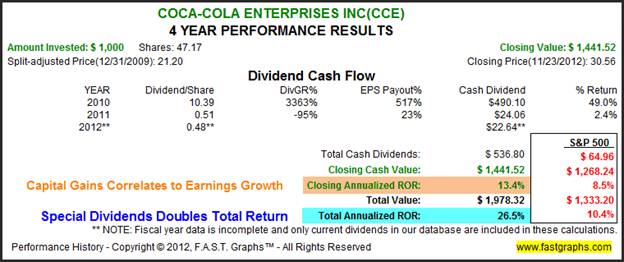
Summary and Conclusions
Directly stated, dividends are one of the two major components of total return, and they provide an enhancement of return to shareholders that own them. Even more simply stated, two companies that generate identical historical earnings growth rates will tend to generate similar to identical capital appreciation components assuming valuation alignment. However, if one of these two companies pays a dividend while the other does not, the dividend payer will provide total returns in excess of what the non-dividend payer provides to its shareholders.
Not only is this common sense, we believe we provided ample evidence within this article to clearly illustrate the veracity of the above statements. Nevertheless, as compelling as the evidence we provided is, we could have provided hundreds and even thousands of additional examples. But that would simply have been overkill. However, the only way that the evidence will resonate is if the reader studies and analyzes the graphs in order to clearly understand what they depict. If they do, they will find that they support the hypothesis and the thesis of this article and our previous article “Dividends Provide A Return Bonus.”
Furthermore, whether a company can grow faster or not if they retain their earnings and reinvest them in their company instead of paying a dividend, is not a relevant issue. Some companies need to reinvest more than other companies in order to grow. However, if they don’t need to invest all of their earnings, then paying them out as a “bonus” to shareholders is a proper use of those earnings. And, if the potential growth rate of the company is slowing, and cannot be accelerated by throwing more money at the company, a dividend component can provide additional shareholder compensation to augment the company’s lower capital appreciation potential.
When all is said and done, dividends are a very important part of the total return potential of any given company. Very fast-growing companies may need to retain their earnings in order to fund their continued growth. These companies often provide a high enough total return to reward shareholders even though they don’t pay a dividend. On the other hand, if the company’s growth rate slows, paying their shareholders a cash dividend is a great way to reward them. This is especially true for those shareholders who are in retirement or approaching retirement and looking for spendable income. Dividends clearly pay a large and important role regarding their shareholders’ profitability, and to state otherwise is simply balderdash.
Disclosure: Long ACN and ROST at the time of writing.By Chuck Carnevale
Charles (Chuck) C. Carnevale is the creator of F.A.S.T. Graphs™. Chuck is also co-founder of an investment management firm. He has been working in the securities industry since 1970: he has been a partner with a private NYSE member firm, the President of a NASD firm, Vice President and Regional Marketing Director for a major AMEX listed company, and an Associate Vice President and Investment Consulting Services Coordinator for a major NYSE member firm.
Prior to forming his own investment firm, he was a partner in a 30-year-old established registered investment advisory in Tampa, Florida. Chuck holds a Bachelor of Science in Economics and Finance from the University of Tampa. Chuck is a sought-after public speaker who is very passionate about spreading the critical message of prudence in money management. Chuck is a Veteran of the Vietnam War and was awarded both the Bronze Star and the Vietnam Honor Medal.
© 2012 Copyright Charles (Chuck) C. Carnevale - All Rights Reserved Disclaimer: The above is a matter of opinion provided for general information purposes only and is not intended as investment advice. Information and analysis above are derived from sources and utilising methods believed to be reliable, but we cannot accept responsibility for any losses you may incur as a result of this analysis. Individuals should consult with their personal financial advisors.
© 2005-2022 http://www.MarketOracle.co.uk - The Market Oracle is a FREE Daily Financial Markets Analysis & Forecasting online publication.



